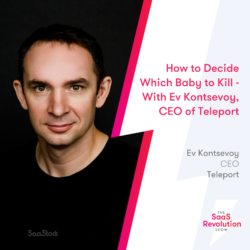As we step into 2024, the landscape of SaaS marketing continues to evolve at a rapid pace. Driven by technological advancements, changing consumer behaviors, and an increasingly competitive market, SaaS companies must adapt and innovate to stay ahead.
In this article, we delve into 13 key predictions for SaaS marketing in 2024. From the integration of AI in personalization and customer service to the strategic focus on minimizing Customer Acquisition Costs (CAC) and enhancing security and privacy measures, these trends are set to shape the future of how SaaS companies connect with and serve their customers. Whether you’re a startup or an established player in the SaaS industry, understanding these trends is crucial for crafting strategies that resonate with your audience and drive sustainable growth.
1. AI-Driven Personalization
Artificial Intelligence (AI) is revolutionizing how SaaS companies interact with their users. By analyzing user data, AI can tailor experiences, content using an AI writer, and recommendations to individual preferences. This hyper-personalization leads to increased user engagement and satisfaction. For instance, a SaaS company offering an email marketing automation tool could use AI to suggest personalized email templates based on the user’s past campaigns and their recipients’ engagement patterns. These AI tools for business not only enhance the user experience but also improve campaign effectiveness. AI’s ability to process vast amounts of data quickly means these personalized experiences are both scalable and dynamic, adapting to user behavior over time.
The AI ad generator has had a significant impact on AI-driven personalization, enabling marketers to create highly personalized and targeted advertisements that resonate with their audience. It has improved conversion rates, customer satisfaction, and freed up resources for marketers to focus on other important aspects of their campaigns. Overall, it has revolutionized the field, enhancing advertising strategies and improving business outcomes.
2. Minimizing Customer Acquisition Cost (CAC)
In 2024, reducing Customer Acquisition Cost (CAC) will be a top priority for SaaS companies. Strategies like refining targeting techniques, optimizing marketing funnels, and leveraging organic growth channels will be key. For example, a project management software company might focus on creating high-quality, SEO-optimized content that addresses specific pain points of their target audience. This approach not only attracts qualified leads but also builds brand authority, reducing reliance on paid advertising and thereby lowering CAC. Additionally, refining onboarding processes to improve conversion rates can significantly impact CAC, making each marketing dollar more effective.
3. Influencer Marketing Expansion
Influencer marketing, traditionally a B2C domain, will gain traction in the B2B SaaS sector. Influencers with niche, industry-specific followings can lend credibility and drive targeted awareness. For instance, a SaaS company specializing in cybersecurity might partner with well-known cybersecurity experts and thought leaders on LinkedIn or Twitter. These influencers can create content around the software, a suite of cybersecurity tools and a Crowdstrike competitor, demonstrating its value in real-world scenarios. This approach not only reaches a targeted audience but also leverages the influencer’s credibility, enhancing brand trust.
4. Integration of AI in Customer Service
AI will play a crucial role in enhancing customer service for SaaS companies. Advanced AI chatbots and AI virtual assistants will provide instant, 24/7 support, handling common queries and troubleshooting issues, which can significantly improve user satisfaction and retention. For example, a cloud storage SaaS provider could implement an AI chatbot that assists users in navigating features, solving common issues, and providing guidance on best practices for data storage. This not only improves the user experience but also reduces the workload on human customer service teams, allowing them to focus on more complex queries.
5. Data-Driven Decision Making
Data-driven decision-making will become more integral to SaaS marketing strategies. Utilizing end-user behavioral analytics tools to understand customer behavior, preferences, and feedback will guide marketing efforts, product development, and customer service improvements. For example, a SaaS company offering a CRM tool could analyze user interaction data to identify features that are underutilized or need improvement. This insight allows for targeted updates and enhancements, ensuring the product evolves in line with user needs and preferences, thereby improving customer satisfaction and retention.
6. Focus on Customer Retention
With an increasingly competitive market, SaaS companies will shift their focus towards retaining existing customers. Strategies like implementing loyalty programs, regular product updates, and enhanced customer support will be key. For instance, a SaaS company providing cloud accounting software might introduce a loyalty program where long-term subscribers get access to exclusive features or personalized support. This approach not only incentivizes continued subscription but also fosters a sense of value and appreciation among users, leading to higher retention rates.
7. Increased Use of Video Content
Video content will become a staple in SaaS marketing strategies. Videos are an effective way to demonstrate product features, share customer testimonials, and provide educational content. For example, a SaaS company offering a digital marketing tool could create tutorial videos showing how to use different features of the tool, whether it be customizing templates, segmenting email lists, or uploading spreadsheets. They may also consider using an AI professional headshot generator to personalize video content further.
These videos not only help in educating current users but also act as a valuable resource for potential customers, showcasing the tool’s capabilities and ease of use.
The impact of an animated logo in increasing the use of video content can also be significant. Here are several reasons why:
- Visual appeal: An animated logo adds an attractive visual element to a video, making it more engaging and visually stimulating for the viewers. It can help grab their attention and make the video more memorable.
- Brand recognition: An animated logo allows the brand to be consistently represented throughout the video content. By incorporating the logo in an animated format, it becomes more noticeable and recognizable, reinforcing brand identity and increasing brand recall.
- Professionalism: Animated logos can add a professional touch to video content. It shows that the brand is investing in the quality and aesthetics of its content, enhancing its credibility and perceived value.
- Differentiation: In a crowded digital landscape, having an animated logo can help a brand to stand out from competitors. It adds a unique and distinctive element, making the brand more memorable and establishing a stronger presence in the minds of the viewers.
- Social media sharing: Animated logos are easily shareable and can go viral on social media platforms. When viewers find an animated logo interesting or visually appealing, they are more likely to share it with their connections, thereby increasing the reach and exposure of the video content and the brand.
8. Rise of Voice Search Optimization
As voice search becomes more prevalent, optimizing for voice search will be crucial for SaaS companies. This involves ensuring content is conversational and answers questions people are likely to ask voice assistants. For example, a SaaS company in the e-commerce space could optimize their content to answer common questions related to e-commerce strategies, such as using composable commerce for SAP, making it more likely for their content to be picked up by voice search devices. This not only improves visibility but also positions the company as a helpful and informative resource in their industry.
9. Sustainability and Ethical Marketing
Sustainability and ethical practices will become important marketing points for SaaS companies. Consumers and businesses are increasingly looking to partner with companies that demonstrate a commitment to these values. For instance, a SaaS company could highlight its use of green data centers or its commitment to data privacy and ethical AI use in its marketing materials. This not only appeals to ethically-minded customers but also helps the company stand out in a crowded market.
10. Expansion of Mobile Marketing
With the increasing use of mobile devices, mobile-first marketing strategies will become essential. This includes creating mobile-optimized content and designing mobile-specific advertising campaigns. For example, a SaaS company offering a mobile app development platform could use targeted mobile ads to reach developers and businesses looking for mobile solutions. By focusing on mobile marketing, the company ensures it’s reaching its audience where they are most active.
11. Interactive Content
Interactive content like quizzes, polls, charts, and infographics will be used to engage users and gather valuable data. For example, a SaaS company providing a marketing automation tool (e.g. cold email automation) could create an interactive quiz helping businesses determine their marketing maturity level. This not only engages potential customers but also provides the company with insights into the needs and challenges of their target market.
12. Account-Based Marketing (ABM) Growth
ABM will become more prevalent in B2B SaaS marketing. This strategy involves creating personalized marketing campaigns targeted at specific high-value accounts. For instance, a SaaS company offering enterprise resource planning (ERP) software could create customized content and tailored demos for key accounts in specific industries. This focused approach ensures marketing efforts are highly relevant and effective for each target account. This is particularly needed in B2B SaaS, where higher-end software purchases have up to 11 key decision-makers in the purchasing process in some countries.
Read more about ABM and other B2B SaaS marketing channels
13. Enhanced Security and Privacy Marketing
With growing concerns around data security and privacy, SaaS companies will use their security measures as a key marketing point. For example, a SaaS company offering cloud-based services could highlight its compliance with international data protection regulations and its use of advanced encryption technologies. Starting in February 2024, stricter email sender requirements will take effect, mandating improved email security practices for companies. By emphasizing security and privacy, the company not only reassures customers about the safety of their data but also differentiates itself in a market where these concerns are increasingly paramount.
Over to you
As we’ve explored, the future of SaaS marketing in 2024 is marked by a blend of technological innovation, strategic focus on customer experience, and a deeper understanding of market dynamics. The integration of AI, a shift towards more ethical and sustainable practices, and the emphasis on data-driven decision-making are not just trends but necessities in the evolving digital landscape. For SaaS companies looking to thrive in this environment, adapting to these changes and anticipating customer needs will be key. By embracing these predictions and incorporating them into your marketing strategies, your company can not only stay competitive but also lead the way in delivering value and innovation in the SaaS industry. The future is bright and full of potential for those ready to embrace change and lead with creativity and insight.




